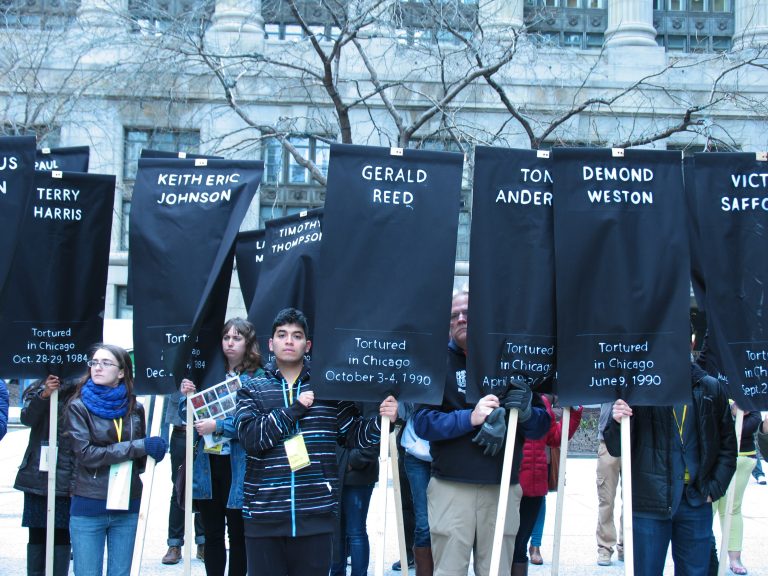The Prompt
Between 1972-1991, former Chicago Police Commander (CPD) Jon Burge and the predominantly white detectives under his command tortured over 120 Black and Brown people. The torture included electrical shock, suffocation with plastic bags, and brutal beatings in addition to verbally abusing people with racist epithets and threats. The torture was used to extract confessions to convict people and, in the case of 11 people, send them to Illinois’s notorious death row.
Prior to joining the CPD, Burge was a military police officer in the Vietnam War, where he was also alleged to have engaged in acts of torture. While Burge was ultimately terminated from the CPD, his disciples were never disciplined, and they continued to coerce scores of Black and Brown people to give false confessions used to secure convictions. Today, there are more than 500 cases under review by the Illinois Torture Inquiry and Relief Commission (TIRC), the only commission in the US that is reviewing cases involving police torture. Public officials at the city, county, and federal levels refused to take action although concrete evidence documents the torture. The legacy of this violence endures today.
For three decades, a grassroots movement comprised of survivors, their family members, attorneys, community activists, educators, and artists fought for justice for torture survivors. In 2013, Chicago Torture Justice Memorials (CTJM) launched a campaign to secure reparations for the Burge torture survivors, their family members, and affected communities. Joined by Project NIA, We Charge Genocide, and Amnesty International USA, the reparations campaign used art, pop-up memorials, rallies, letter writing, Twitter power hours, light installations, and street demonstrations to successfully demand that the City of Chicago pass reparations legislation. On May 6, 2015, Chicago’s City Council unanimously passed a Reparations Ordinance, becoming the first municipality in the US to provide redress for racially motivated state violence.
The survivors of this torture have spent decades in prison. As of 2021, 55 individuals tortured by Burge or his disciples were exonerated or acquitted of the crimes they were forced to confess to. Other survivors served their sentences but continue to suffer from the effects of torture and the stigma of their wrongful convictions. While some survivors have been released and some were exonerated on the basis of their innocence, many are still in prison as a result of convictions based in whole or in part upon their coerced confessions and are waiting for their cases to be reviewed.
In addition, a key component of the Reparations Legislation — a permanent memorial — has not been fulfilled. Chicago Torture Justice Memorials has been working with city officials for more than five years but has not had a meaningful commitment to create the memorial from either Mayor Emanuel’s or Mayor Lightfoot’s administrations.
This activity involves listening and reading stories from survivors and families of survivors; and, when possible, visiting the sites of torture and resistance.
Activate a Site
Visit Chicago Torture Justice Memorial’s interactive map in the RE:ACTION Exhibition to view sites of torture and the stories of survivors in “Narrating the Struggle for Justice of Jon Burge Torture Survivors: A Guide.” All sites on the map are on the South and West sides of Chicago and represent a meaningful story in the history of police torture in Chicago and the struggle for justice. CTJM members, survivors, and families of survivors have created ways for you to activate these sites and their histories.
Choose a site or story that connects with you and follow the related prompt below to complete the activation if you are able to visit the site.
If you are unable to visit these sites in Chicago, two activation activities by Bertha Escamilla and Dorothy Burge invite you to activate these histories from anywhere in the world.
For each prompt, use a mobile phone or camera to photograph your site activation. Upload your media using the submission form at the bottom of this page.
By activating each site, we seek to never forget this past, to reflect on the ongoing trauma torture creates, and to work toward a more just Chicago.
For more stories from survivors of Chicago Police torture, view the Chicago Police Torture Archive online.
Prompts
Select a prompt to activate a specific site, or complete an activation from anywhere.
- Chicago Police Area 2 Police Headquarters, 91st and Cottage Grove and 111th and Ellis
- Chicago Juvenile Intervention Support Center, 3900 S. California Ave
- Chicago Police Station, 51st and Wentworth Ave
- Lakefront Trail at Oakwood Blvd
- Activate any site
- Activations you can do from anywhere
Chicago Police Area 2 Police Headquarters, 91st and Cottage Grove and 111th and Ellis
Jon Burge and his disciples have been accused of torturing over 80 people at these two headquarters. 91st and Cottage is now a “Community Justice Center” of the Cook County State’s Attorney’s Office. 111th and Ellis is the current site of a police station and municipal court. Follow the directions to activate this site.
STEP 1:
Use sidewalk chalk to write on the public sidewalk or light poles on 111th St. and point to the buildings with arrows and directional signs.
STEP 2:
Write one of the following statements:
- Chicago Police Tortured Chicago Residents Here
- Jon Burge and his henchmen tortured Black and Brown people here
- Torturers worked here
- Never Forget: This police station was used as a torture chamber from the 1970s-1990s
- Demand Justice
STEP 3:
Take a photo of your work and share it using the submission form at the bottom of this page.
Chicago Juvenile Intervention Support Center, 3900 S. California Ave
Marcus Wiggins was 13 years old when he was picked up and tortured by Chicago Police at this site. Kilroy Watkins and many others were tortured here too. This location is now a “Chicago Juvenile Intervention Support Center.”
STEP 1:
Print out this “Know Your Rights” booklet from the National Lawyers Guild.
STEP 2:
Do one of these two actions:
- Give the booklet to a young person walking by. Let them know this is courtesy of Marcus Wiggins, who was a young person tortured by Chicago Police at this site.
- Affix or place the “Know Your Rights” booklet on the building for a passerby to read.
STEP 3:
Take a photo of your activation and share it using the online submission form at the bottom of this page. Be sure not to include the faces of participants without their consent.
Chicago Police Station, 51st and Wentworth Ave.
At 51st and Wentworth, you are on the site where police tortured Reginald Henderson, his brother, and so many other people.
STEP 1:
Go into the building and ask someone at the front desk:
- “What can you tell me about Officers John Halloran, Michael Clancy, and William Foley?”
- “Officers Boudreau, McSweeny, Mozart, O’Brien, and other officers are alleged to have tortured young Black and Brown people here. Have you heard that before?”
- “Do you know the stories of Reginald Henderson, Sean Tyler, or other survivors of torture?”
STEP 2:
Leave the building and record a recap of your experience on your mobile phone.
STEP 3:
Share your recording using the submission form at the bottom of this page.
Lakefront Trail at Oakwood Blvd.
Taliah Williams reminds us that torture is pain. Carl and Taliah Williams want participants to symbolically release the pain felt by torture survivors.
STEP 1:
Write the name of a torture survivor on a ribbon and tie it to a tree on the Lakefront at Oakwood Blvd.
STEP 2:
Take several deep breaths in honor of the survivor and say: “I want to release this pain.”
STEP 3:
Take a photo of your ribbon affixed to the tree and share it using the submission form at the bottom of this page.
Activate any site
Kilroy Watkins reminds us that many survivors are still fighting their cases and still don’t have court dates. He says, “Many people think it is a moment in time that ended. They don’t realize that many of us are still in court, still incarcerated. Still fighting.”
Kilroy asks you to visit any site from the CTJM map and light a candle, or lay a rose, in the memory of a torture survivor. Take a photo of your commemoration and share it using the submission form below.
Activate these sites from anywhere
Dorothy Burge invites participants to create a postcard with a message to honor survivors of police torture. Photograph your postcard and share it using the submission form below.
Participants can also send their postcard to Chicago Torture Justice Memorials, and it will be incorporated into a fabric quilt that will become part of a memorial to the history of the cases and struggle for justice.
Bertha Escamilla asks participants to follow Moms United Against Violence and Incarceration and find ways to support families with loved ones who are incarcerated and to attend their annual Mother’s Day Vigil at Cook County Jail.
Respond to CTJM's Prompts
Questions? Visit our FAQ page. By submitting your response to this prompt you agree to the Terms & Conditions.
"*" indicates required fields
Pain in the Soil: Sites of Resistance to Chicago Police Torture
Envisioning Justice


 636
636